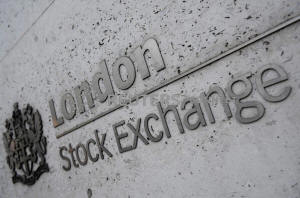Oil pinballs off 1999 lows, stocks clamber higher
 Send a link to a friend
Send a link to a friend
 [April 22, 2020]
By Marc Jones [April 22, 2020]
By Marc Jones
LONDON (Reuters) - Oil took markets on
another rollercoaster ride on Wednesday as Brent somehow managed to
reverse an early 12% crash to 1999 lows and give battered
petrocurrencies and stock markets something buoyant to climb on.
The wildest trading in oil market history continued with benchmark Brent
initially swallow-diving below $16 a barrel, after U.S. crude prices had
gone deeply negative earlier in the week, only to then rally to nearly
$20.
With coronavirus lockdowns slashing demand for everything from petrol to
jet fuel, and markets still bloated by a turf war being fought by Saudi
Arabia and Russia, places to store the excess supply are running out.
Christopher Peel, CIO of Tavistock Wealth, said eight oil supertankers
were now moored on the river outside his window in the Portuguese
capital Lisbon.
"There is nowhere to put the oil so it shouldn't come as any surprise to
anyone that the front months (oil price contracts) are getting
decimated," Peel said, though he predicted it should be a relatively
temporary situation.
As well as the fightback from oil, there was encouragement that Europe's
main stock markets were moving higher after a poor close overnight in
New York and a mixed day for Asia.

Focus was on whether European Union leaders, who meet on Thursday, will
be able to agree more aid to help the region cope with the coronavirus
outbreak. Recent days have seen a blizzard of fresh stimulus announced
in other economies.
The pan-European STOXX 600 index and Wall Street futures were up around
1%, after both went tumbling more than 3% on Tuesday following the
collapse in oil prices.
Italian shares gained 1.2% and the government's bond yield steadied
after Prime Minister Giuseppe Conte said Italy, one of the countries hit
hardest by the pandemic, could start pulling out of strict stay-at-home
orders from May 4.
Traders were also buoyed after Italy breezed through a major debt sale
on Tuesday and speculation continued that the European Central Bank
would provide more support measures.
"It's no surprise that we see (bond yields slipping) today," said DZ
Bank strategist Sebastian Fellechner, citing the conclusion of Italy's
jumbo bond sale.
"Brent is stable this morning...This is also reflected then in the
government bond market, in that we see spreads are stabilising and
(core) yields are slightly higher this morning."
Germany's 10-year yield was up 2 basis points to -0.46%. The five-year
U.S. Treasuries yield also rose to 0.35% after hitting a record low of
0.3010% on Tuesday. The 10-year notes yield stood at 0.58%, still near
last month's record lows caused by panic buying.
[to top of second column]
|

The London Stock Exchange Group offices are seen in the City of
London, Britain, December 29, 2017. REUTERS/Toby Melville

MAGIC MONEY FORESTS
While a Reuters tally shows there have been more than 2.5 million
cases globally of the COVID-19 respiratory disease caused by the new
coronavirus, another $500 billion in relief has come through for the
U.S. economy, and the governors of half a dozen U.S. states are
planning to reopen business.
Restrictions are tentatively being lifted in a host of countries and
many more are unveiling stimulus measures. South Africa’s president
pledged a $26 billion rescue package on Tuesday for his country's
economy, which was suffering from anaemic growth even before the
coronavirus outbreak.
Mexico unveiled a $31 billion package and cut its benchmark rate by
50 basis points, Turkey cut by another 100 basis points while South
Korea readied a third supplementary budget and a $32.4 billion fund
to prop up its economy.
"If the global economy can reopen in eight weeks or so the damage is
done (for equity markets), but the longer-term damage is in the bond
markets," said Tavistock's Peel, warning of the huge rise in debt
levels as countries ramp up aid.
U.S. stock futures had bounced back to be about 1% higher after
Tuesday's falls.
In the currency market, the dollar had levelled out after rising
when investors fled oil-linked currencies such as the Norwegian
crown, Russian rouble and Canadian dollar.
The safe-haven yen held firm at 107.79 to the dollar while the Swiss
franc stood near five-year high against the euro at 1.05255 franc.
Norway's crown and the rouble both recovered though, and the
Australian dollar was up 0.8% after a record surge in retail sales
last month spurred by panic buying.

(Editing by Timothy Heritage/Mark Heinrich)
[© 2020 Thomson Reuters. All rights
reserved.] Copyright 2020 Reuters. All rights reserved. This material may not be published,
broadcast, rewritten or redistributed.
Thompson Reuters is solely responsible for this content. |